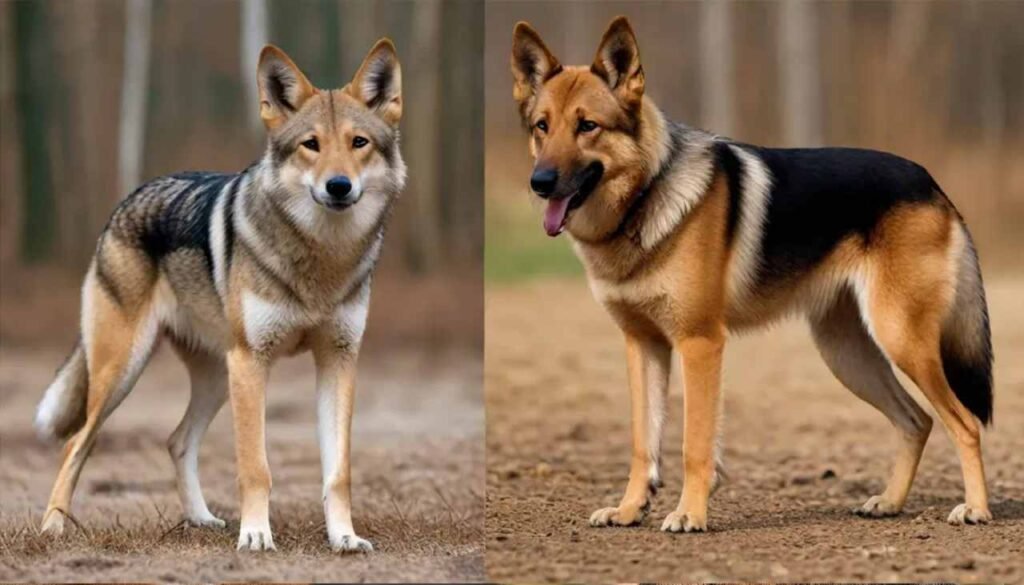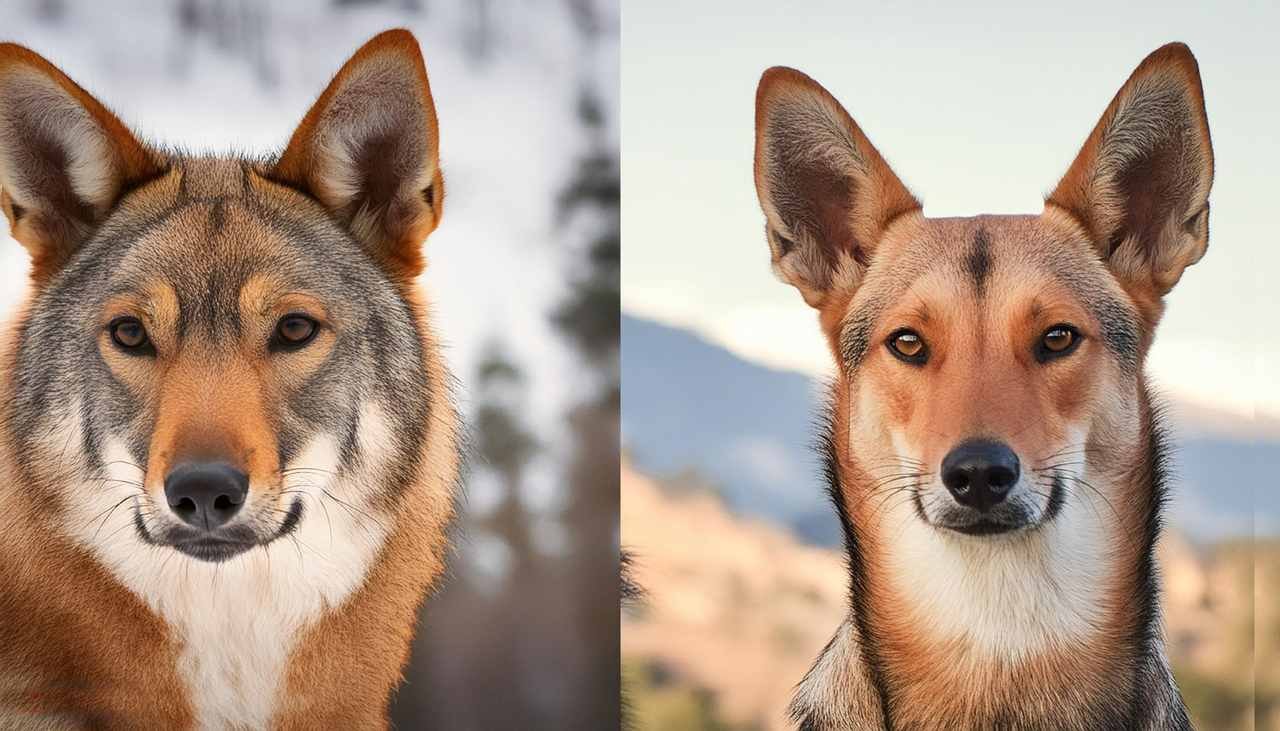Hunting safely and effectively means telling coyotes from dogs, a vital skill. Though they seem alike at first, these dog relatives have unique looks, sounds, and actions. This clear, straightforward guide pinpoints the main ways coyotes differ from dogs, letting hunters feel self-assured in the field.
Spot the Differences: Distinguishing Coyotes in the Field
| Feature | Coyote | Dog (varies by breed) |
|---|---|---|
| Body Type | Lean and athletic | Wide range – stocky, slender, muscular |
| Tail | Bushy, held low | Varies – curled, drooped, held high |
| Muzzle | Narrow and pointed | Broader, rounder snout in many breeds |
| Ears | Smaller, positioned high on head | Varies – floppy, pointed, size and position vary |
It’s essential to correctly spot your quarry for fair hunting methods. Let’s take apart the main physical features that set coyotes apart from dogs:
Built for the Wild: Coyote Physical Traits
- Lean Build with Long Legs: They are built for long chases. They have thin bodies and long legs, perfect for covering miles and catching prey.
- Bushy Tail for Balance: The coyote uses its thick tail for balance while making quick twists and agile moves. This is key for moving through thick bushes and rough ground.
- Narrow Muzzle and Pointed Snout: Hunting small preys like mice and rabbits needs special equipment. They have thin muzzles and sharp noses, different than some dogs.
- Smaller Ears: Unlike some bigger dogs, coyotes have petite ears. They sit at the top of the head, adding to their unique look.

Domesticated Diversity: Dog Breeds and Traits
Dogs, unlike coyotes, are diverse in shape and size. Check out these key aspects:
- Wide Range of Body Types: Different dog breeds display a multitude of bodily figures. Strong, sturdy breeds such as Bulldogs are made for jobs such as cart pulling, while speedy, flexible breeds like Greyhounds are naturals at chasing quarry.
- Tail Carriage Varies: A dog’s tail form can greatly differ from breed to breed, not like a coyote’s constantly fluffy tail. Some breeds, like Pugs, have tails that naturally curl, while some, like Beagles, have downcast tails. Breeds like German Shepherds keep their tails aloft.
- Broader Head and Rounder Snout: A number of dog breeds, especially those created for tasks such as fetching or livestock guarding, have wider heads and curvier noses than a coyote’s slender features.
- Floppy or Pointed Ears: Dogs can display a variety of ear styles, from the droopy ears of a Basset Hound to the pointed ones of a German Shepherd. Ear stance and dimension can also differ by the breed.
Beyond Appearances: Decoding Vocalizations
Physical traits can give key hints, but comprehending the sounds they make can boost your ability to tell coyotes and dogs apart in the wild. Discover the Wild Calls:

The Language of the Wild: Coyote Howls and Calls
CoyotesCoyotes, they’re chatterboxes, chit-chatting in their own special ways. They got a couple key sounds.
- Howls: Think of this as their shout-out. They’re carving out space, calling their buddies, even wooing their sweethearts.
- Yips, Barks, and Whines: This is their everyday talk. They’re sharing news about where to grab dinner, if there’s danger afoot, and just shooting the breeze.
Understanding Your Dog’s Signals: Decoding Dog Barks and Whines
Knowing what your hunting dog’s noises mean is key for good communication and a great hunt. Let’s discuss usual dog barks and whines:
- Barks: Dogs bark for lots of reasons, like warning their human about possible risks, showing joy during a hunt, or hinting they want to play.
- Whines: Dog’s whining can share a variety of feelings like being upset, submissive, or hurt. Knowing what your dog’s individual whines mean can assist you in fixing potential issues.
| Vocalization | Coyote | Dog |
|---|---|---|
| Howl | Defines territory, locates pack members, attracts mates | Uncommon, may indicate excitement, loneliness, or anxiety |
| Yip | Communication within the pack (prey location, danger) | Playful excitement, seeking attention |
| Bark | Alerts pack to danger, various barks for different reasons | Alerting, fear, excitement, communication with handler |
| Whine | Submission, pain, fear | Submission, sadness, pain, seeking attention |
Hunting Strategies: How Behavior Affects Encounters
It’s important to realize how coyotes and dogs behave differently. This knowledge can shape your hunting plans. Take a quick look at how a Coyote hunts:
The Opportunistic Hunter: Coyote Predatory Instincts
Coyotes are opportunistic predators, adapting their hunting tactics based on available prey. Here’s a breakdown of their behavior:
- Primarily Hunt Small Mammals: Coyotes usually pursue small creatures such as rabbits, rodents, and ground birds. They use their sharp senses of vision, smell, and hearing to expertly track and capture these small prey.
- May Target Livestock if Available: Not their main prey, but coyotes might go after vulnerable livestock, especially young or unwatched animals. This often causes disputes with farmers and cattle owners.
- Highly Adaptable: Coyotes aren’t like some specific hunting hounds. They are greatly adaptable eaters. They eagerly look for dead animals to eat or quickly munch on fruits and vegetables if available. This versatility helps them to live in diverse habitats.
The Loyal Companion: Dog Behavior in the Field
Dogs trained for hunting, thanks to careful breeding and education, show behaviors that make them helpful allies on the hunt. They’re pretty different from coyotes, and here’s how:
- Trained Hunting Focus: Instead of being like the chance-driven coyotes, trained dogs target specific game which they’ve been taught to. They help hunters hit the mark by doing this efficiently.
- Less Likely to Target Livestock: Owing to dedicated training and inbuilt obedience, dogs are not prone to target livestock like coyotes do. This makes them handy for hunters on farms or ranches.
- Barking Behavior: The sound of a dog barking is quite an effective tool when pursuing. Their barks notify hunters of nearby game, creating a smarter approach to the hunting procedure.
| Feature | Coyote | Dog (Trained Hunting Dog) |
|---|---|---|
| Prey Focus | Opportunistic – targets small mammals, may scavenge | Focused – targets specific prey based on training |
| Livestock Predation | May target vulnerable livestock | Less likely to target livestock due to training |
| Barks | Alerting barks uncommon | Barks can alert hunters to nearby prey |
Conclusion: Respecting the Differences for a Safe and Successful Hunt
Knowing the differences between theses two helps hunters safely and respectfully do their jobs. It’s crucial to note why:
- Avoid encounters: By spotting coyotes properly, hunters avoid run-ins with these animals. This cuts down on possible bush-ups or disease spreading.
- Using Dog Traits: Identifying specific dog breeds helps hunters use their skills. For instance, a Beagle’s top-notch nose sense is excellent for tracking small game. A Greyhound’s speed and nimbleness are useful for chasing fast prey.
Actionable Tips: Putting Knowledge into Practice
With the understanding of the crucial contrasts between coyotes and dogs in your pocket, let’s transform this information into practical steps for your future hunting adventures:
- Learn Coyote Vocalizations: Understand the different sounds it make, like howls, yips, and barks. This intel will let you know if there are coyotes in your hunting zone and can help you sidestep any problems.
- Train Your Dog to Differentiate: You need to educate your hunting dog to tell the difference between coyotes and the game you’re aiming for. Do this by exposing your dog to the noise and smell of coyotes during training.
- Maintain a Safe Distance: Always stay at a safe distance from any coyotes you come across. They are wilderness animals and so need to be handled with caution. Prevent luring them into your hunting area by timely dumping food leftovers and waste.
Knowing how coyotes differ from dogs helps hunters stay safe and fair when in nature. Good hunting habits benefit the whole environment, taking care of free and tame dogs too.
- New Jersey Outdoors: 2025-2026 Hunting Season Dates and Rules - August 28, 2025
- North Dakota’s Hunting Guide: 2025-2026 Season Dates And Regulations - August 18, 2025
- 2025 Hawaii Hunting Dates and Hotspots - August 18, 2025

